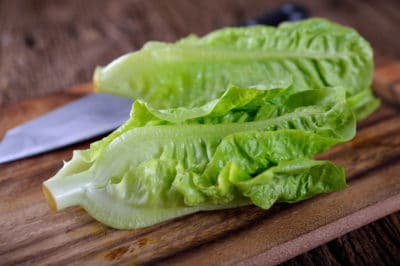Indoors
After you buy a head of Romaine lettuce and eat it, you are left with that hard white stem where the leaves were held together. This piece is usually thrown away, put in the compost or worm bin, or fed to the hens. But there’s more to this little vegetable scrap. It actually contains nodes that will root if given water.
Whether you are looking to save money, gain access to fresher vegetables, do a fun winter project with kids, or just scratch that mid-January gardening itch; this project is quick, easy and rewarding.
What you’ll need:
- Romaine stem
- Dish or Jar
- Fresh water
- Sunny windowsill
Steps for Regrowing
It’s so simple. Fill a shallow dish with just enough water to cover the whole bottom of the stem, between 1/2 and 1 inch. Place your stem in the water and set the dish on a windowsill that gets some sunlight.
Keep an eye on the water. It will need to be changed every few days, anytime it looks stagnant or foggy. After a few days, the plant will start to regrow. Small roots will begin to stick out of the base of the stem. Leaves will sprout from the center of the top-side of the stem.
After about a week in the glass, your lettuce plant will have green, new leaves bursting from the center. This is about the maximum harvest for a plant in water. At this point, you can eat your fresh greens or you can pot the lettuce stem in some soil for a longer lasting plant.
It will never again form a tight head like the original one that was eaten. But, it will continue to give leaves for a few weeks until finally, it begins to elongate and flower.
In the Garden
There are ways to harvest Romaine in the garden and allow it to continue to grow. First, you can treat it like a cut-and-come-again green. Do this at any time during the plant’s growth, many gardeners will harvest baby romaine this way. Cut the head off with a sharp knife, leaving about 1-2 inches of stem sticking out of the soil.
Doing this when the plant is in its baby stage, at about 25 days, is often more successful than waiting for a mature head. The greens that regrow, like the windowsill plant, won’t form another head. They will form a loose cluster of baby Romaine leaves that look great and taste just as delicious as the original.
Regrowing for seed
One great way to save money on seed for the garden is collecting your own. Make sure the plant that you save seed from is an open-pollinated variety, not a hybrid. Hybrid seeds will not produce the same variety when planted. Instead, the offspring will be a mix of genetics from the parent plants.
For this reason, regrowing Romaine lettuce from a grocery store for seed is not the best option. Buy lettuce from a farmer’s market or use this method to get two harvests from your garden Romaine plants; a lettuce harvest and a seed harvest.
Let the lettuce grow a full head. Make note of which plants perform the best, these are the ones to save seed from. Harvest the head but leave 1-3 inches of stem in the ground. This will sprout new leaves which you can also harvest. Eventually, the plant will elongate and send up a central flowering shoot.
This shoot will first produce flowers and then seed. Collect the seed by hand, each plant will produce dozens of potential new plants. Doing this every year will strengthen and acclimate your lettuce to the conditions in your garden.
If you are wanting seed from a market vegetable, sprout the stem according to the above instructions. When it roots, pot it in some soil and keep it in the window. It will grow new leaves for a couple of weeks, then it will begin to flower. Indoor plants may not produce the quantity of seeds that outdoor plants will. Outdoor plants root systems are larger and more established.
Regrowing allows you to get more from your produce purchases and garden vegetables. It takes very little time, and the supplies are typically on hand. Try it out!
